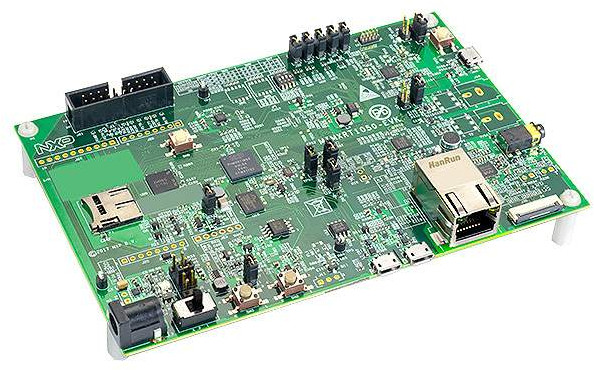NXP iMX RT series is a family of ARM Cortex M7 processors clocked at 600 MHz, making the solution a “crossover embedded processor” bridging the gap between real-time capabilities of micro-controllers and the performance of application processors.
This week, NXP provided some benchmark numbers for i.MX RT1050 processor, which delivers a CoreMark score of 3020, DMIPS of 1284, and 20ns interrupt latency at 600 MHz, which means it could be a good candidate for embedded Linux, and Emcraft Systems has just released a uCLinux BSP for the NXP i.MX RT1050 EVK board.
The BSP features U-Boot v2017.09-rc1, Linux Kernel 4.5 with relevant device drivers such as key I/O interfaces, Wi-Fi, SD card, LCD, etc…, and GNU development tools such as a GCC 4.7 toolchain, GDB, and so on.
The company has made a demo with a GUI application designed with Crank Software’s Storyboard Suite, and running in Linux on the NXP i.MX RT1050 evaluation kit

The binary files for the demo, and BSP documentation can be downloaded freely on the product page, and the complete BSP with source code costs $99. I understand you can then use it in your product without having to pay any extra royalties.

Jean-Luc started CNX Software in 2010 as a part-time endeavor, before quitting his job as a software engineering manager, and starting to write daily news, and reviews full time later in 2011.
Support CNX Software! Donate via cryptocurrencies, become a Patron on Patreon, or purchase goods on Amazon or Aliexpress






I didn’t know Linux works on such small RT systems, it’s cool.
However what is less cool is that they’re providing a dead kernel in which at least 4000 known bugs have not been fixed. Indeed, assuming they’re on the latest 4.5 kernel (4.5.7), no less than 3984 bugs were fixed in the 4.4 LTS branch since this version was issued, *all* of them affect 4.5, and this doesn’t account for those which affect 4.5 and not 4.4 (hence not counted here). It’s not even imaginable to think they backported all these fixes by themselves considering how hard it is to do correctly for old kernels despite the use of public review, maintainers feedback and automated builds and boots. Or if they did this, it’s even worse because without the help from this public reviews, they necessarily did wrong things many times.
I wish software vendors start to learn from their mistakes and consider using LTS kernels which are maintained for them and make their work much easier! What is sad is that many customers are not aware of this and will continue to buy such unmaintained stuff, and continue to expose themselves (and their customers) to thousands of bugs and vulnerabilities that could trivially have been avoided.
By the way, despite relying on a dead kernel tree, at least it should be noted that they comply with the GPL and their sources are available on Github : https://github.com/EmcraftSystems/linux-upstream/tree/linux-cortexm-2.5.0 (it’s even mentioned on the product page, which is clean). So anyone willing to port their work to a maintained kernel with enough spare time could do it and is not locked-in.